We Tested the Highest Rated Espresso Machines on the Market—These Are the 7 Best Worth Investing In
Going without your morning shot of espresso is tough, but even harder than that? Forking up the bills every single day to expense your coffee habit—which is probably why you’re here researching for the best espresso machines. If you’re heading to Starbucks for your double shot of espresso one too many times a week and are putting a dent in your checking account, consider making espresso at home; it can save you some cash, while controlling the quality of your espresso from the comfort of your own home (now that’s something we can sip to).
One of the best ways to mimic cafe-quality espresso is by using a high-quality espresso machine. Sure, it may require some legwork and be costly at first, but if you’re drinking espresso daily, it’s totally worth the time and investment. Not sure where to start? Lucky for you, we tested the most popular espresso machine brands: These are the ones that make the best espresso, are easiest to use, and are completely worth the investment.
Best espresso machines, at a glance
- Best overall: Breville, Express Impress, $720
- Best budget: Nepresso, Vertuo Next, $216
- Best low-maintenance: Philips, 3200 Automatic Espresso Machine, $799
- Most stylish: Smeg, Espresso Machine, $530
- Best for latte art: Delonghi, La Specialista Arte Espresso Machine, $500
- Best combination: Mr. Coffee, One Touch Espresso, Cappuccino, and Latte Maker, $350
- Best for pro baristas: Breville, Barista Pro, $650
What to look for in an espresso machine
Type of machine
The first thing to note is that there are different types of espresso machines: fully-automatic, semi-automatic, and manual. As the name implies, fully-automatic machines are like planes on auto-pilot; it grinds your coffee, packs the grounds, and brews espresso with just a click of a button. On the other hand, semi-automatic models will require some leg work, such as filling a portafilter, aka a holder for ground espresso, and tamping your grounds down. Both of these options are great if you’re new to at-home brewing.
If you’re an espresso aficionado, though, you might appreciate a manual espresso machine—which embraces a more hands-on brewing experience. They don’t have all the bells and whistles of fully- and semi-automatic machines. Things like temperature and automated pressure sensors don’t exist on manual mode. For this article, we tested automatic and semi-automatic machines.
Material and versatility
Once you’ve picked the type of machine you’re going to use, Genevieve Kappler, director of coffee and brewing and roasting technologist at Roasting Plant Coffee, recommends looking at the material. For example, stainless steel is “easy to clean and maintain,” Kappler tells us. You also might just like the way it looks.
While some machines stick strictly to espresso, there are others that brew up lattes, cappuccinos, as well as Americanos. Versatility matters, so if you envision yourself whipping up something more than just shots, Kapper recommends going with a versatile machine that can do it all.
Space and water storage
“The amount of counter space you have and how often you plan to make espresso will help determine the size of the tank and boiler,” says Kappler. “I suggest at least 1.5 liters or more, or you’ll end up having to refill all the time!”
What makes a good or tasty espresso
It’s all in the beans! The fresher, the better. To tell if your beans are good, “look for the crema when brewing espresso or bloom of foam as a visual indicator; crema is an indicator of freshness,” she says. “Not having the crema can be a sign the espresso beans are now stale.” Womp, I know. Once you have ’em, Kappler suggests brewing your beans within seven to ten days.”People don’t typically typically think of coffee beans as a food that can go bad, but coffee drinkers should treat their coffee beans like fresh fruit and vegetables or baked goods,” Kappler explains.
The final verdict will come down to you. Delicious espresso depends on how you like the bean’s bitterness, acidity, and aromatics, says Maciej Kasperowicz, director of Coffee at Trade based in Brooklyn.
One things for certain: the Well+Good team loves their coffee, so we put seven espresso machines to the test. Ahead, you’ll find machines made espresso-ly for you.
Best overall
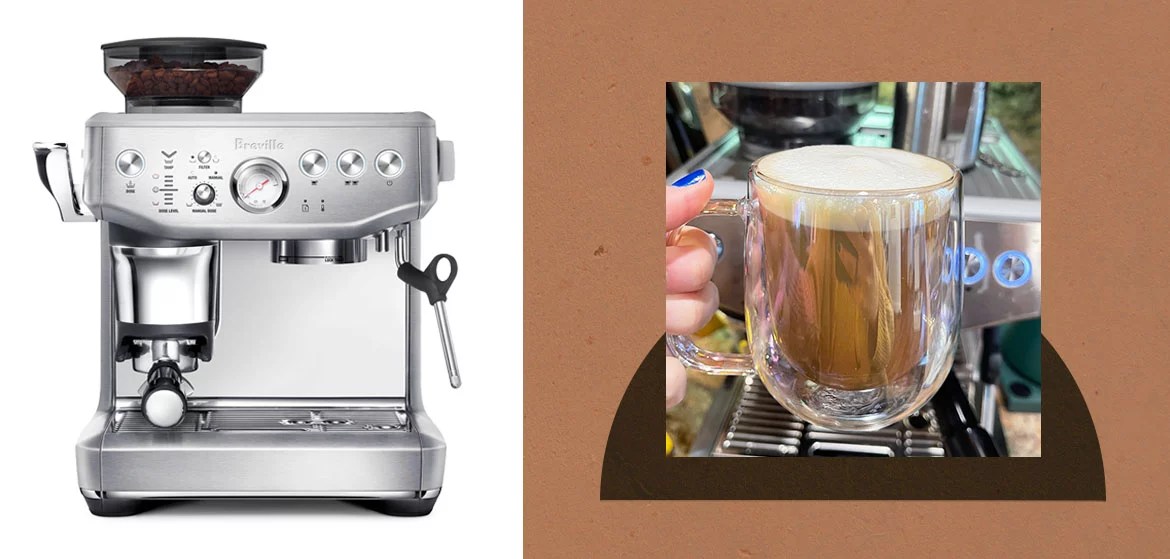
Breville, Express Impress — $720.00
“The Breville Barista Express Impress is probably as close to a professional espresso machine as you can get—without having to deal with a professional espresso machine. It’s nice and compact (not as small as the Bambino Plus, though, which I used to own and loved), and super easy to use. I’m an incredibly tired, lazy person (who is really not technical at all) in the morning, but making myself a latte using the Express Impress only takes a few minutes.
To use, you simply slide in the portafilter, press on the “Dose” button (you can hold it so that it automatically fills it with ground espresso, or manually choose the amount you want). Then, you press down on the handle on the side and its assistant tamping feature will press down on the espresso, packing it in. Next, attach it to the part of the machine that creates the espresso (choose between single or double shot). And then steam your milk if you want with the steam wand! I had to brush up on my foaming skills (I was a barista in college for a bit, so it wasn’t too bad—but it’s not hard to learn using YouTube!), but the wand was incredibly simple to use. You can also just leave it in and make steamed milk.
The results are a perfectly hot espresso drink. I haven’t bought a latte from a coffee shop since I’ve owned the Impress!
Cleaning the machine is easy—a little sign will automatically pop up telling you it’s time to dump the extra liquid (leftover espresso water and milk), which I’ll do and quickly rinse. And every six months or so (it depends how often you use it—I use mine multiple times a day) you’ll have to descale the whole machine, which is a bit of a process, but it’s simple enough—you just use the descaling powder the Impress comes with, and run it through the whole thing using the water tank so it gets rid of build up. You’ll also want to soak your portafilter in a descaling solution once or twice a year, since if you’re an avid espresso drinker, they can potentially get clogged after a while.” – Gina Vaynshteyn, editorial commerce director
Type: Semi-automatic
Features:
- Built-in coffee bean grinder
- “Intelligent” dosing
- 25 grind settings
- Thermocoil heating system
- Manual steam wand
- Preset single or double shot
- Ability to make hot water
- Adjustable brew temps
Accessories included:
- Portafilter
- Milk jug for steaming milk
- A precision razor
- Cleaning tablets
- A steam wand cleaning tool and a cleaning brush
- Descale powder
Warranty: 2 years
Dimensions: 12.9″ x 14.9″ x 16.1″
- Easy to use
- Creates professional-quality espresso
- So! Many! Features!
- Durable
- Simple to clean
- Makes a latte in minutes
- Not automatic like a Nespresso
- Requires whole beans (which can be pricey)
- Expensive
- Requires some maintenance
Best budget
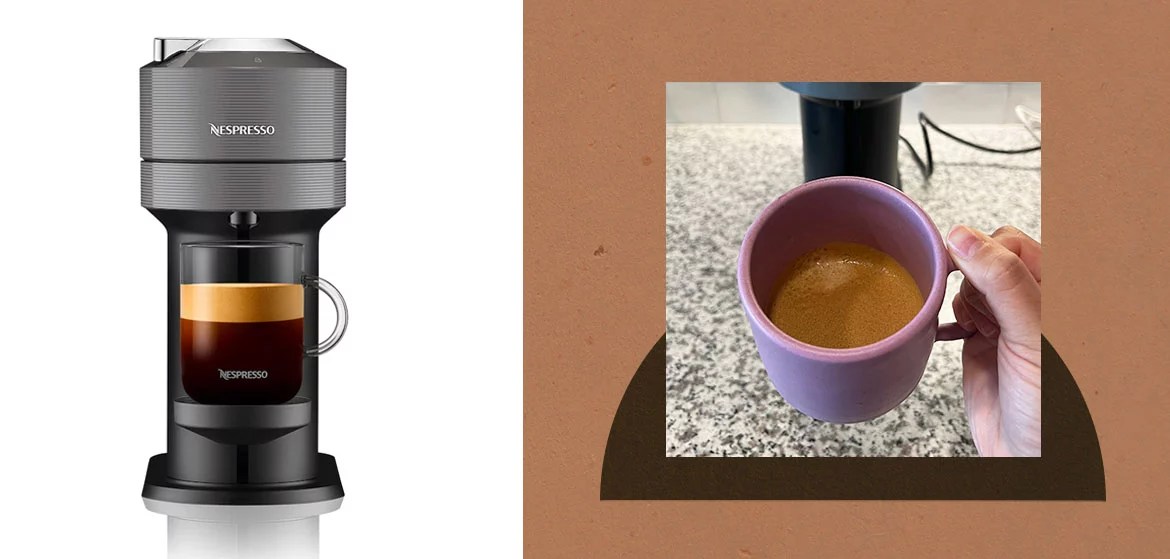
Nepresso, Vertuo Next — $216.00
“As you know, espresso machines aren’t cheap, but this no-frills device brews espresso, double espresso, and coffee with just a click of a button and for under $250, it’s a price you can’t beat. For a jolt of caffeine, I load a Nepresso pod into the machine, put my cup on the adjustable cup holder, and watch it brew me a delicious cup of Joe or a powerful kick of espresso within 30 seconds. The end result? Jittery and chatty Kayla…that’s how you know the caffeine works.
Unlike other espresso machines on this list, this one has no extra bells and whistles. However, for the price, it makes sense that it doesn’t have all of the extra features like a milk frother, tamper, or portafilter. I do appreciate the pod self-emptying feature because once the pod door is opened, it self-empties and ejects the capsule into a removable container—which holds up to 10 capsules. So, clean up is easy as pie!
What’s great about the machine is that it’s compatible with the Nepresso app, where you can order more pods or brew with just a touch of your phone. Unfortunately, my machine wasn’t connecting to the app, so I could not use this feature.
All in all, if a simple espresso machine is what you seek, I’d recommend Nepresso’s Vertuo Next. It’s easy to use, clean, and delivers shots wickedly fast.” – Kayla Hui, commerce writer
Type: Automatic
Features:
- 25-second brew time
- Removable water tank
- Used capsule container
- Self-emptying feature
- Adjustable cup holder
Accessories included: none
Warranty: 1 year
Dimensions: 5.5″ x 16.8″ x 12.4″
- No-frills design
- More affordable compared to other machines on the list
- Makes quality espresso
- Features a pod waste bin
- Sturdy design
- Easy to use and clean
- Must purchase special Nepresso pods
- Water tank is relatively small (1.09L)
- Closing lid may be difficult for some
- App connectivity issues
Best low-maintenance
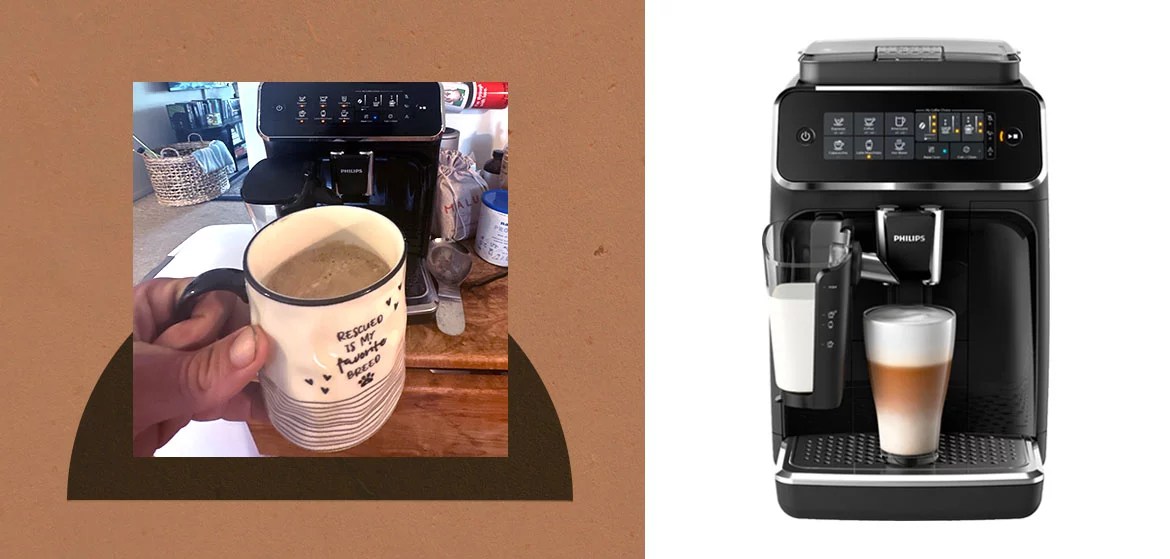
Philips, 3200 Automatic Espresso Machine — $799.00
“I have been hesitant to bring a high-tech espresso machine into my home because I have a love/hate relationship with anything that claims to be ‘smart’ or ‘automatic.’ That’s usually code for ‘needing fixing all the time,’ and who has the time for that? I’m eating my words, though, because the Philips 3200 Automatic Espresso Machine LatteGo is *actually* low maintenance and reliable. And for especially being a box that spits out ready-made, coffee shop-level espresso drinks after pressing a couple buttons, that’s really dang impressive.
Set up is simple—the hardest part is installing the included water filter (included) into the tank. Once installed though, making a cafe-worthy cup of coffee is easy peasy. You can use either whole beans or ground coffee; for whole beans, you just pour your beans into the hopper on top, select which beverage you want to make (either single or double servings, depending on the serving), along with the aroma setting and cup size, and press “start.”
More convenient is the LatteGo system, which is a total game-changer for making lattes, macchiatos, and other milky drinks. There are no tubes or steam nozzles to hassle with; all you do is fill up the LatteGo cup with milk—which sits on the outside of the machine—select your frothy drink, and press “start.” By using a “cyclonic frothing technology,” the LatteGo releases a stream of microbubbles to create a creamy, decadent foam directly in your cup or mug. When you’re done, just unclip the LatteGo cup and throw it in the dishwasher—there’s no extra cleaning required. It’s truly seamless and takes about two minutes total to make professional quality drinks in the comfort of your own home.
Since using my Philips 3200 series, I have noted it’s easier to use it with whole beans than pre-ground coffee. If you’re using grounds, you can only make one cup at a time, and the process requires a few extra steps than if you just stick with whole beans. Additionally, the water tank is smaller than I’d like it to be, and by the time my boyfriend and I are done making our 2-3 cups in the morning, we often have to refill it for the other to use.
These minor downsides aside, it’s convinced me that an automatic coffee machine is the investment every caffeine lover should make. If said caffeine lovers want quality coffee or lattes in the press of a button, the Philips 3200 LatteGo has got you covered.” – Francesca Krempa, associate commerce editor
Type: Automatic
Features:
- Built-in coffee bean grinder
- 5 beverage settings (espresso, coffee, cold brew, latte, americano)
- 12 grind settings
- 3 aroma settings
- Automatic LatteGo milk froth system
- Preset single or double shot
- Ability to make hot water
- Adjustable brew temps
Accessories included:
- Measuring scoop
- Water hardness test strip
- AquaClean filter
- LatteGo storage lid
- Grease tube
Warranty: 2 years
Dimensions: 9.7”x14.6”x17”
- Easy to set up and use
- Completely automatic
- Compatible with whole and ground beans
- Makes professional-quality espresso
- LatteGo is simple and fast
- Easy to clean
- Water tank is relatively small (1.8L)
- Expensive
- Switching from whole bean to ground coffee can be inconsistent
Most stylist

Smeg, Espresso Machine — $530.00
“As a habitual moka pot user, I appreciate that Smeg’s Manual Espresso Machine doesn’t overwhelm you with bells and whistles. It gives me the core coffeeshop fixtures that make me feel like a professional at home—the portafilter and steam wand—and there are only four buttons on the entire machine: a power button, single and double cup brew buttons, and a steam button to ready the steam valve. Beyond learning how to use the steam valve (which you’ll get the hang of after one or two tries), the machine itself is super straightforward.
It doesn’t have a grinder, so you’ll need to start with ground coffee, and it comes with one and two-cup filter baskets that can be swapped out with ease when you’re in need of an extra dose of caffeine. To use, just power on the machine, load up the portafilter, twist it in place, tap your brew button (once the lights have stopped blinking to indicate it’s reached brewing temp), and you’ll get a smooth cup of espresso in a pinch. For foamy milk, just tap the steam valve button to heat it up, and pull the lever—while submerging the valve in milk—for a quick and satisfying steam. Warning: you’ll feel like a professional barista while you do this. The result is a consistently delicious and easy to make espresso, which my slow morning brain truly appreciates.
Thanks to its simple mechanics and user-friendly design, the Smeg is easy to clean. Just dump out the coffee grounds and rinse out the filter, and wipe the steam valve clean with a damp cloth.
And obviously when it comes to style, few do it better than Smeg. The Italian home appliance brand is known for its gorgeous, retro look that brings a modern flair to any kitchen. And I can tell you that its Espresso Coffee Machine looks just as stunning in person as it did on my Pinterest board. The glossy exterior and polished chrome accents do the impossible task of dressing up my old granite countertops, and the cream colorway (there are several color options to choose from) totally brightens up the space.
One important thing to note, however, is that save for the stainless steel accents, the body of the machine is plastic, which is admittedly a bummer given the high price and luxe aesthetic. It also makes the machine very lightweight, which means you’ll have to awkwardly hold it down as you twist the filter back into place to avoid it moving around your counter (even with the anti-slip feet)—it gets easier the more I use it, but it’s worth noting given the machine’s hefty price tag.” – Alexa Casanova, freelance writer
Type: Semi-automatic
Features:
- Manual steam wand
- Thermoblock heating system
- Ability to make hot water
- Adjustable coffee size
- Decalcification alarm
- Adjustable coffee temps
- Holds up to 1 liter of water
Accessories included:
- Portafilter
- 1 and 2 cup filters
- Paper pod filter
- Measuring scoop
Dimensions: 13″ x 5 7/8″ x 13″
Warranty: 1 year
- Easy to use
- Makes quality espresso
- Easy to clean
- Makes hot water
- Makes steamed/frothed milk
- Stylish retro design
- Slips around on your counter due to the lightweight design
- Plastic body doesn’t feel luxe
- Expensive
Best for latte art
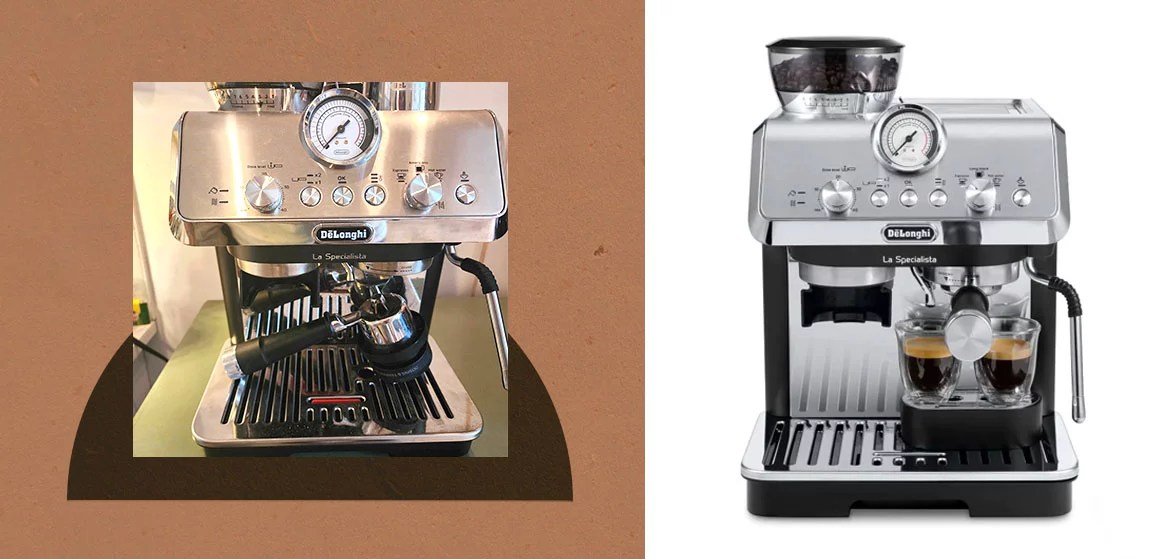
Delonghi, La Specialista Arte Espresso Machine — $500.00
Originally $700, now $500
“Little daily rituals ground my day—and making myself a latte (or three!) using the DeLonghi La Specialista Arte ($500) is one of my favorites. I love waking up in the morning and hobbling over to my personal cafe, filling my space with the smell of coffee, and making a professional-level drink while I’m still in my PJs.
It starts by hitting the “OK” button and seeing the machine light up. (I interpret the flashing to mean “Good morning! I’m ready!!!!!”). I place the dosing funnel onto the portafilter and press it toward the back of the machine for it to dose out freshly ground beans. The Arte has precise settings, so I’m able to set the perfect dose amount and water temperature for the bean type whenever I refill. However, the settings in the booklet don’t always work out perfectly so it can take some trial and error.
Once the grinding stops, I tamp the grinds down. Unlike some of Delonghi’s pricier models, the Arte requires manual tamping. I’ve used both and I prefer the manual tamp because it 1. makes me feel more like a barista and 2. it doesn’t include a big tamping lever on the side, taking up less counter space. To tamp, I take the portafilter off, tap the side to even out the beans, and use the included tamper and tamping mat to press down the beans.
Next, the tamping funnel comes off and the portafilter twists into the brewing water. Then, I choose if I want a single or a double shot of espresso, and twist a dial to choose whether I want just espresso or an Americano (espresso + hot water). I can also just pull hot water and not coffee. If I want a frothed drink, I pour my milk of choice—pistachio milk—into the milk pitcher (shout out to my monthly subscription to Táche, the best alt milk). Then, I use the steam wand to get the milk all hot and bubbly and top off my drink.
To keep the machine sparkly and clean, I wipe it down after use (making sure to get any residual milk off the wand) and make sure to dump out any excess water that collects in the drip tray (a little red bobbly thing pops up to let you know when it’s filling up). Because my roommate and I basically have coffee instead of blood in our veins, a red light pops up every three-ish months telling us to descale the machine. It takes about an hour and involves water and DeLonghi’s Eco-Decaulk Descaler ($25). It’s not hard, but it is involved, so if you’re curious watch this vid instead of having to read me try to explain it.
I’ve had my machine since August and love it like a child. Sadly, it did spring a violent leak about five months in, making it impossible to use. But, DeLonghi has a great warranty—two years standard and an additional year if you register your machine online. So after a quick video call with a DeLonghi Specialist (Thanks, Guy!!!), I was able to mail out my unit for repairs and got it back a few weeks later good as new.
If you’re a coffee lover who wants an intelligent machine that still leaves room for a little fun and artistry, the DeLonghi La Specialista Arte is perfect.” – Kara Brown, beauty writer
Type: Semi-automatic
Features:
- Built-in coffee bean grinder
- 8 grind setting
- Thermoblock heating system
- Manual steam wand
- Preset single or double shot
- Ability to make hot water
- Adjustable brew temps
- Auto shut-off
- Removable water tank
- Removable drip tray
- Water level indicator
Accessories included:
- Portafilter
- Dosing funnel
- Stainless Steel Milk Frothing Jug
- Tamper
- Tamping mat
- Total Hardness Test
- Cleaning Brush
- Descaler 100ml
- Single coffee filter
- Double coffee filter
- Cleaning needle for steam nozzle
- Instruction Manual & Quick Start Guide
Dimensions: 11.22″ x 14.37″ x 15.87″
Warranty: 2 years + 1 if you register
- Easy to use
- Compact for what it offers
- Looks stunning on my counter
- Brews delicious espresso
- Froths milk like a pro
- Manual tamping
- Requires whole beans (which can be pricey)
- Expensive
- Descaling is a bit annoying
- Requires some maintenance
Best combination
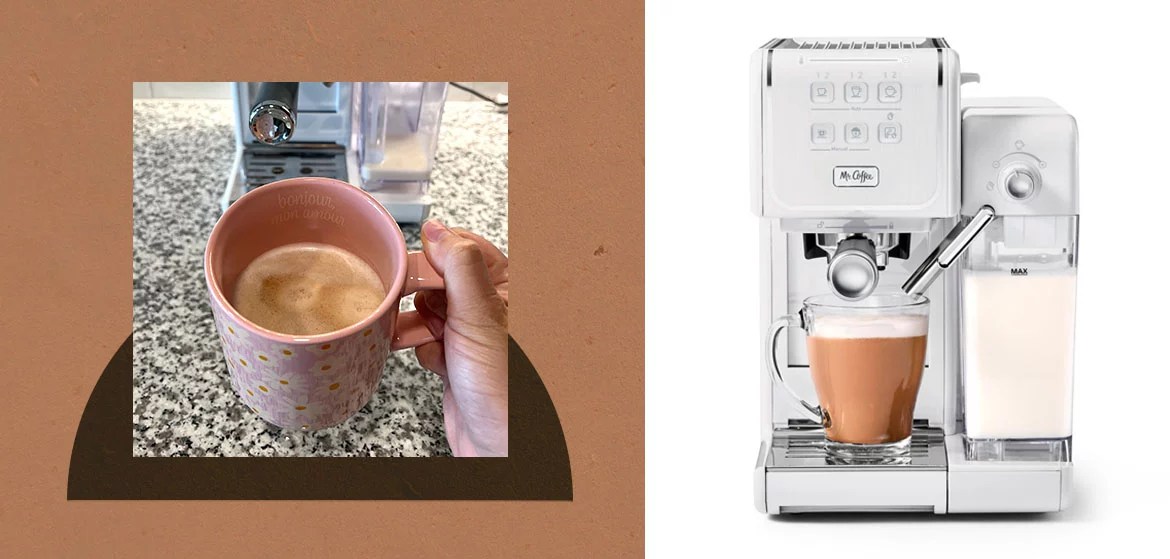
Mr. Coffee, One Touch Espresso, Cappuccino, and Latte Maker — $308.00
Originally $350, now $308
“Froth? I want ALL of it, and Mr. Coffee’s One Touch Espresso Machine makes it easy to whip up all kinds of drinks. As the name implies, with just a push of a button, you can have a latte, espresso, or cappuccino within minutes. For pro baristas or coffee fanatics, there’s also a manual button for each of the coffee settings, so you can configure the right dosage.
What I love about this machine is the portafilter and automatic milk frother. As someone who likes to take it easy in the morning, it’s a breath of fresh air not to worry about grinding or manual frothing with this machine. The One Touch comes with a portafilter, which takes coffee grinds, giving you the feeling of a being behind the barista counter minus the actual stress of having to determine the grind size. To use the frother, I just add milk in the container and click it back into the machine. If I want more froth, I just turn the dial. The result is a fluffy, cloud-like latte that’s too yummy to put down.
I do wish the water container was a bit larger than the frothing reservoir (it holds 18 ounces of liquid)—they are about the same size—so I didn’t have to worry about refilling it so quickly. One thing to consider is that this machine has a “warm-up” time. The progress bar at the top will illuminate in increments. Once it’s ready to brew, the whole bar will glow, but this process can take up to two minutes (a little bit long, if you ask me). Another caveat is the plastic and lightweight build. It can be hard to lock in the portafilter without the machine moving around, but I just hold down the machine to ensure the filter locks in place. Things to love, though: The tamper is built into a measuring spoon, so you can scoop the grinds and tamp with the same tool.
For the money, this machine creates a good selection of drinks, and is a great combo machine to have on the counter. What also helps? It looks chic and stylish. If you love a variety of drinks, but want the ease of use in making them, consider Mr. Coffee.” – Kayla Hui, commerce writer
Type: Semi-automatic
Features:
- Progress bar for when machine is ready to brew
- One-touch control panel
- Automatic frother
- Milk reservoir
- Water reservoir
- Adjustable cup tray
Accessories included:
- Single and double shot filters
- Measuring scoop and tamper
Warranty: 1 year
Dimensions: 14.7″ x 8.5″ x 12.6″
- Has a milk and water reservoir
- Manual and automatic modes
- Makes espresso, cappuccino, and latte
- Automatic milk frother
- Plastic body doesn’t feel luxe
- Latte dosage is smaller
- Takes roughly two-minutes to “warm up”
Best for pro baristas
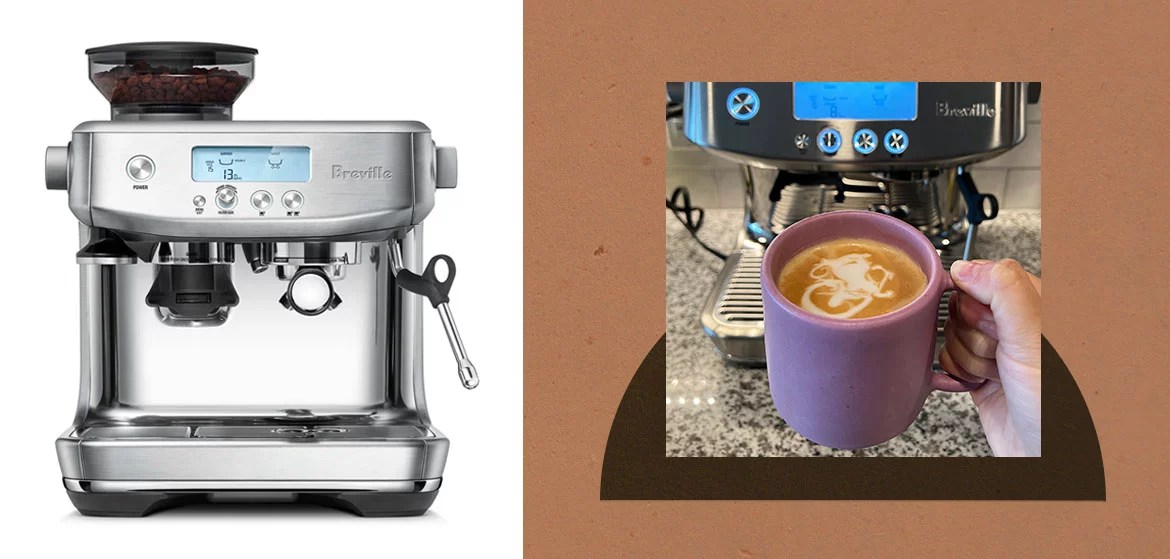
Breville, Barista Pro — $680.00
“I’m nowhere near retirement age, but my dreams of owning a coffee shop in my elderly years and channeling my inner barista came early. As a full disclaimer, I’m not a pro barista—I just aspire to be one, but this machine has already set me up for success.
The machine comes with a built-in grinder and a heavy duty, stainless steel portafilter that makes getting the first part of espresso-making easy. All I have to do is load the portafilter in the grinder port, push the filter in once, and watch as all the espresso-y goodness fall down. Here’s where pro barista experience is needed: You have to determine the grind size, which can be adjusted with a built-in dial.
Once the grinding is done, I use my tamper and tamp, tamp, tamp (because I like mine extra flat), and lock the portafilter back into the brewing port. Within seconds after pushing the espresso making button, I have a shot (or two) of espresso. The part where I feel like a true barista is when I have to froth the milk. Included in the kit is a stainless steel milk frothing cup, where I pour my milk of choice: Minor Figures Oat Milk. It takes under a minute to get hot, and once it’s ready, I pour all of the frothy goodness into my cup. I love this feature a latte. Can you tell?
It is worth noting that the machine retails for a hefty $680, which is a ton of coins if you don’t plan on drinking coffee on the daily. However, if you’re going to be espresso-ing it up frequently, it’s a sound investment. The nice perk is the stainless steel build; it’s a durable machine with tough accessories, so this machine is going to last me a LONG time. Since using it, I barely go out for coffee, which means more moolah for me.” – Kayla Hui, commerce writer
Type: Semi-automatic
Features:
- Built-in coffee bean grinder
- Adjustable grind control with 30 grind settings
- Thermojet heating system
- Manual steam wand
- Preset single or double shot
- Ability to make hot water
- LCD screen
Accessories included:
- Portafilter
- Milk jug for steaming milk
- A precision razor
- Cleaning kit
- A steam wand cleaning tool and a cleaning brush
- Filter baskets
Warranty: 2 years
Dimensions: 13.9″ x 13.5″ x 16″
- Built-in grinder
- Simple to clean
- Stainless steel build
- Can make lattes in minutes
- Expensive
- Not easy to use for beginners
- Requires whole beans (which can be pricey)
Our editors independently select these products. Making a purchase through our links may earn Well+Good a commission.
For more latest Food & Drinks News Click Here

